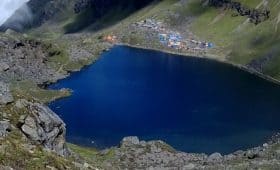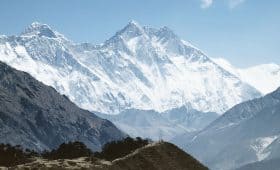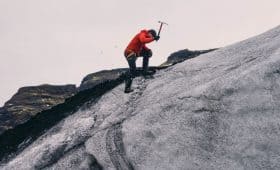In this post, I’m excited to share an in depth, comprehensive guide to the Everest Base Camp Trek. As a local expert with over 15 years of experience organizing various treks, including trek to Everest Base Camp, I offer you firsthand knowledge that will prepare you for this incredible journey.
Before we delve into the details, let me assure you that this guide is based on personal insights and expertise from years of leading adventurous trekkers like yourself.
Going on EBC Trek is once-in-a-lifetime adventure that offers experience of a lifetime where you can view breathtaking Himalayan landscapes, glimpse into Sherpa culture and religion and the unmatched experience of standing at the base camp of the world’s highest peak Mt Everest.
In this all inclusive guide, I am going to provide you with all the essential information to plan and complete this incredible journey.
From the logistics of the trek to the preparations needed, we will cover it all and answer all questions related to this incredible life-changing journey.
Let’s dive in!

Table of Contents
- The Ultimate Guide to Everest Base Camp Trek – Everything You Need to Know
- 1. What is Everest Base Camp Trek?
- 2. Why Everest Base Camp Trek?
- 3. How is Everest Base Camp Trek?
- 4. How long is Everest Base Camp Trek?
- 5. How difficult is the Everest Base Camp Trek?
- 6. Can you trek to Everest Base Camp on your own? Do you need a guide to trek to EBC?
- 7. How far is Everest Base Camp Trek? How many miles is Everest Base Camp Trek?
- 8. How much does Everest Base Camp Trek cost?
- 9. How much money to take on Everest Base Camp Trek?
- 10. How to do Everest Base Camp Trek? How to prepare for Everest Base Camp Trek?
- 11. Is Everest Base Camp Trek worth it?
- 12. Is it dangerous or safe to trek to Everest Base Camp?
- 13. Can anyone trek to Everest Base Camp?
- 14. Can kids do the Everest Base Camp Trek?
- 15. How high is Everest Base Camp Trek?
- 16. When to do Everest Base Camp Trek?
- 17. Can you trek to Everest Base Camp during the monsoon season?
- 18. Can you trek to Everest Base Camp during the winter season?
- 19. Do I need insurance for Everest Base Camp Trek?
- 20. Do you lose weight on Everest Base Camp Trek?
- 21. How busy or crowded is Everest Base Camp Trek?
- 22. How many people do Everest Base Camp Trek?
- 23. How many suspension bridges are on Everest Base Camp Trek?
- 24. How much is food on Everest Base Camp Trek? What to eat on the Everest Base Camp Trek?
- 25. How much to tip your guide and porter on Everest Base Camp Trek?
- 26. How often are trekkers affected by altitude sickness on Everest Base Camp Trek?
- 27. How to avoid altitude sickness during your Everest Base Camp Trek?
- 28. How steep is Everest Base Camp Trek?
- 29. Is there a phone connection at Mt. Everest Base Camp Trek?
- 30. Is there a Wi-Fi connection at Mt. Everest Base Camp Trek?
- 31. When to exchange money for Everest Base Camp Trek?
- 32. Where does Everest Base Camp Trek start from?
- 33. Which trek is harder between Everest Base Camp or Kilimanjaro?
- Conclusion
The Ultimate Guide to Everest Base Camp Trek – Everything You Need to Know

1. What is Everest Base Camp Trek?
Everest Base Camp Trek is a most popular trekking route in Nepal that takes you to the base camp of world’s Highest Mountain Mt Everest.
Starting from Lukla, EBC trek follows a path through stunning landscapes, Sherpa villages and ancient monasteries that leads to the Everest Base Camp at 5,364 meters (17,598 feet).
EBC holds great importance as the starting point for climbers aiming to reach top of the Everest; and for trekkers, it offers incredible views, cultural experiences, and a sense of achievement.
2. Why Everest Base Camp Trek?
Because Everest Base Camp Trek is one of most popular trek in the world among adventure seekers for many compelling reasons.
First of all, this trek offers mouth opening and amazing scenery with panoramic views of Himalayan peak including Mount Everest.
Secondly, it provides a sense of achievement and adventure allowing trekkers to push their limits and overcome challenges that one encounters along the way to the top.
Additionally, EBC trek offers cultural experience, interacting with Sherpa communities and locals and visiting centuries old monasteries.
The mix of amazing Himalayan landscapes, physical achievement, cultural exploration and life changing experience makes the Everest Base Camp Trek an unforgettable and sought-after adventure among trekking lovers all around the globe.
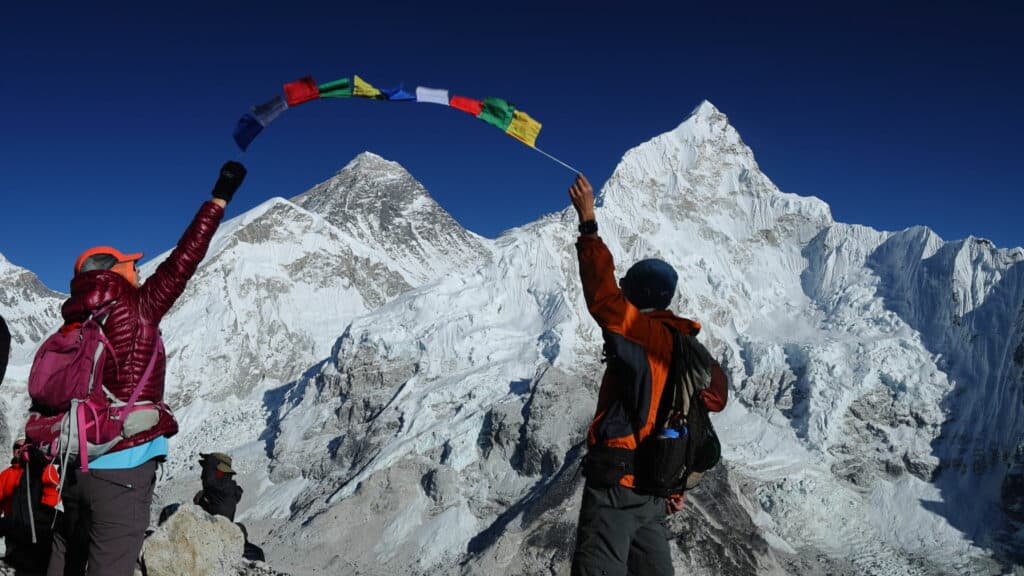
3. How is Everest Base Camp Trek?
Everest Base Camp Trek is a challenging yet immensely rewarding adventure that requires physical endurance and mental preparation.
It is standard 12 days trek that takes you through diverse terrain, including steep ascents, rocky paths, and high-altitude environments.
Eye catching mountains, beautiful landscape and sense of achievement make this a trek of a lifetime.
4. How long is Everest Base Camp Trek?
Duration of the Everest Base Camp Trek can vary depending on the chosen itinerary.
Popular option is the 12 days one (without Kathmandu) that provides a properly paced journey to Everest Base Camp and back allowing proper acclimatization and enjoyment of the stunning landscapes.
Want more information? Send us your query, and our experts will get back to you within 24 hrs.
5. How difficult is the Everest Base Camp Trek?
Everest Base Camp Trek is considered difficult trek as it involves waking each day for several hours on trail with varying level of difficulty.
You will walk through steep ups/downs, narrow trails, cross high suspension bridges and walk over 3500 meters for couple of days in thin air.
Altitude sickness is a common concern during Everest Base Camp Trek, so it is important that you acclimatize properly and follow slow and steady pace as instructed by your local guides.
Adequate physical fitness, prior hiking experience, and acclimatization (go slow) for the altitude are essential.
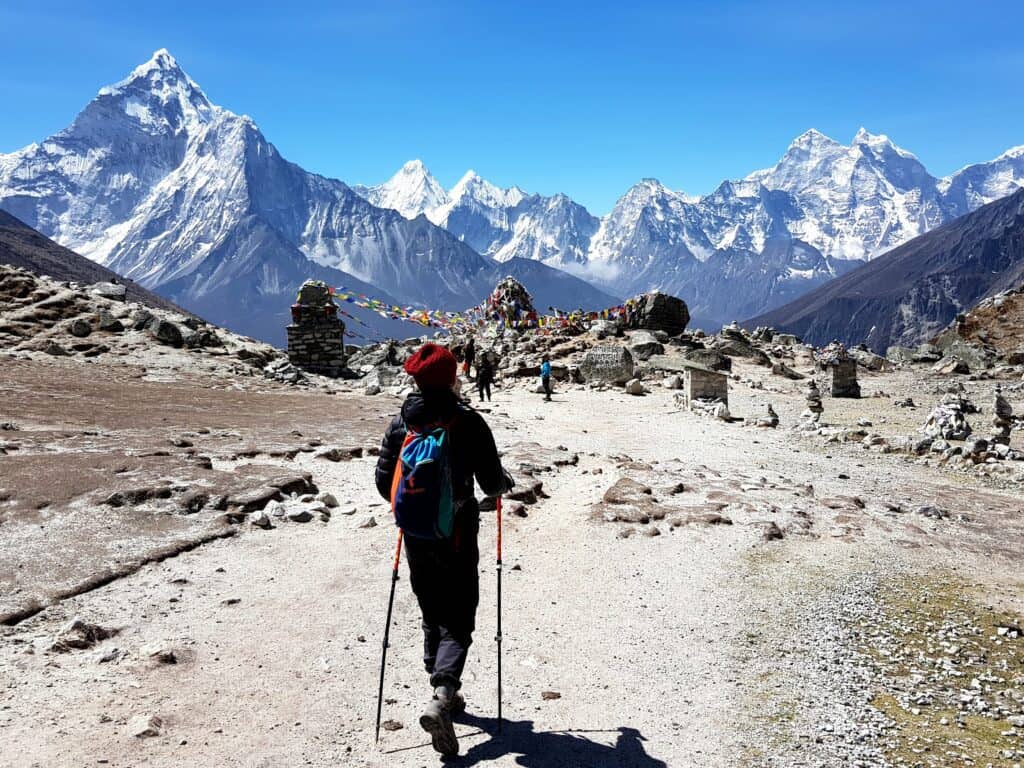
6. Can you trek to Everest Base Camp on your own? Do you need a guide to trek to EBC?
Trek to Everest Base Camp without a guide is possible but it comes with both pros and cons.
Going solo allows for more flexibility in terms of itinerary and pace, and it can be a more budget-friendly option as you don’t have to pay for guide wages and tipping. But safety can be a crucial concern.
Professional guides provide expertise in getting you out of challenges that you encounter during adventure.
Guide can be helpful while walking along challenging terrains, they handle altitude sickness related issues, take immediate and action and provide solution in case of emergencies.
If you have prior high altitude trekking experience and good navigation skills you might be able to do it with proper preparation and experience some great adventure too.
However, for most trekkers, hiring guide for Everest Base Camp is highly recommended for their own safety, especially those without high altitude experience.
7. How far is Everest Base Camp Trek? How many miles is Everest Base Camp Trek?
Everest Base Camp trek covers a total walking distance of approximately 130 kilometers or 80 miles.
This route takes you through various scenic Himalayan landscapes and high altitude landmarks, including Lukla, Namche Bazaar, Tyangboche Monastery, Khumbu Icefall and finally reach Everest Base Camp at an altitude of 5,364 meters or 17,598 feet.

8. How much does Everest Base Camp Trek cost?
Current cost of the Everest Base Camp trek is USD 1445 per person.
This includes arrival/departure airport transfers, hotel in Kathmandu, trekking permits, flights to Lukla (the starting point of the trek), accommodations in teahouses along the everest base camp trek, meals, guide, porter and other necessary services.
9. How much money to take on Everest Base Camp Trek?
When purchasing a package for Everest Base Camp trek, most expenses are typically covered. However, there are additional expenses that you may need to budget for EBC Trek.
These include costs for tea/coffee, bottled beverages, bottled water, Wi-Fi, battery charging, hot water, souvenirs,, emergency situations etc.
To cover these expenses, it is advisable to bring approximately NPR 15,000 to 20,000 per person (equivalent to about 150-200 USD/person).
This will provide you with some flexibility and ensure you have enough money for any additional needs.
10. How to do Everest Base Camp Trek? How to prepare for Everest Base Camp Trek?
To prepare for Everest Base Camp Trek, follow these steps:
- Research and choose reputable trekking operator like Mosaic Adventure.
- Plan your trek, considering the itinerary and season and get the right tool like Everest Base Camp Trek Map.
- Gather essential gear such as sturdy trekking boots, layered clothing, sleeping bag, proper backpack, daypack, trekking pole etc. For detailed information on packing, go through this ultimate packing list for Everest Base Camp Trek.
- Engage in physical training to build endurance and strength including cardiovascular exercises and go for occasional hiking.
- Consult with your doctor about altitude medicine, such as Diamox. Try to use diamox few months before the trek and see if you have any negative reactions such as blurry vision.
- Mentally prepare yourself for this trek by setting expectations, understanding of the challenge and maintaining a positive mindset.
- When on trek – stay hydrated, eat nutritious meals and don’t forget to acclimatize properly.
- Always follow the guidance of the guide and be aware of altitude sickness symptoms. Speak to your guide immediately if you are not feeling well.
- Enjoy the journey, embrace the amazing Himalayas and respect local culture and environment of the Khumbu Region.
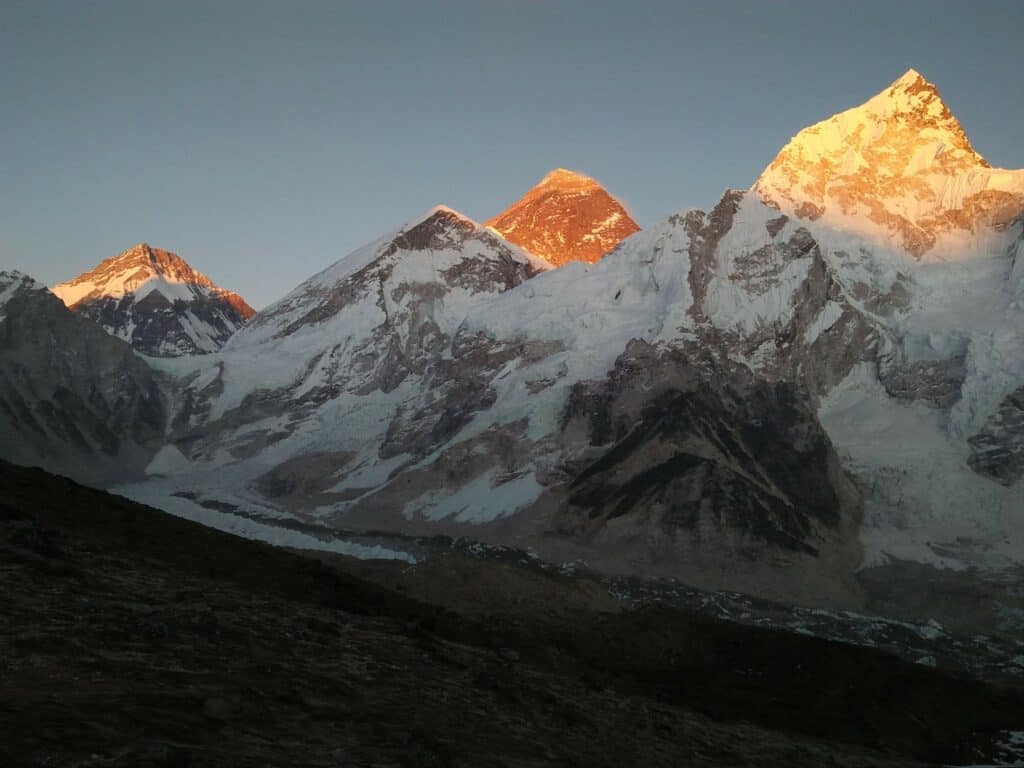
11. Is Everest Base Camp Trek worth it?
Everest Base Camp Trek is often considered a highly rewarding and worthwhile experience by those trekkers who have done it.
EBC trek offers breathtaking scenic beauty, with amazing views of Himalayan mountains, glaciers and picturesque valleys.
This trek also provides an opportunity for cultural immersion as you pass through Sherpa people, local villages, and monasteries experiencing the unique Himalayan way of life.
Completing this challenging trek can also mean a significant personal achievement, testing your physical and mental limits.
12. Is it dangerous or safe to trek to Everest Base Camp?
Trekking to Everest Base Camp comes with natural risks, primarily related to altitude sickness. Going on high altitude can cause symptoms ranging from mild discomfort to life threatening conditions.
Weather conditions including snowstorms and avalanches can also pose dangers. However, with proper acclimatization, physical preparation and following safety precautions, such as gradual ascent, staying hydrated, and following the guidance of guides, EBC trek can be completed safely.
It is essential to be aware of above risks, regularly assess your health and take necessary precautions to ensure a safe trekking adventure.
13. Can anyone trek to Everest Base Camp?
For a trek to EBC, one requires a certain level of physical fitness and endurance and is feasible for a wide range of individuals.
Although EBC trek does not require technical climbing skills or prior mountaineering experience, it is important to have a basic level of fitness and stamina to tolerate the challenging terrain and high altitude.
Regular exercise can help you prepare for the EBC trek so allow few months preparation before signing up on this adventure.
With proper preparation and guidance many people with average fitness levels have successfully completed this incredible trek to Everest Base Camp.
14. Can kids do the Everest Base Camp Trek?
Well, it is not a simple yes or no. If you are thinking about taking your kids on this trek, think about how tough it is and if your child can tell you if they feel unwell.
Everest Base Camp trail is hard. It’s about 130km long with steep uphills and downhills, high altitudes and different types of terrain. Even if your kids are really fit and can handle lots of hiking, remember this isn’t an easy walk. Even adults who are fit sometimes struggle with feeling sick from the high altitude, the cold, the not-so-comfy places to stay and the new foods they might not be used to.
So, unless your kids really want to do it themselves, understand how tough it can be and can tell you if they feel bad, it might be better to wait until they are older and can decide for themselves. Don’t push them to do something just because you want an adventure. They have plenty of time to do the trek when they’re older and more ready for it.
15. How high is Everest Base Camp Trek?
12 days trekking from Lukla to Everest Base Camp involves gradual altitude gains.
Starting from Lukla at 2,840 meters (9,318 feet), trekkers gradually ascend through various altitude points including Namche Bazaar at 3,440 meters (11,286 feet), Tyangboche at 3,860 meters (12,664 feet).
From Dingboche we start our journey going above 4000 meters.
Starting with Dingboche at 4,410 meters (14,468 feet), we head to Lobuche at 4,910 meters (16,108 feet), Gorak Shep at 5,164 meters (16,942 feet) and then final ascent to Everest Base Camp at 5,364 meters (17,598 feet).
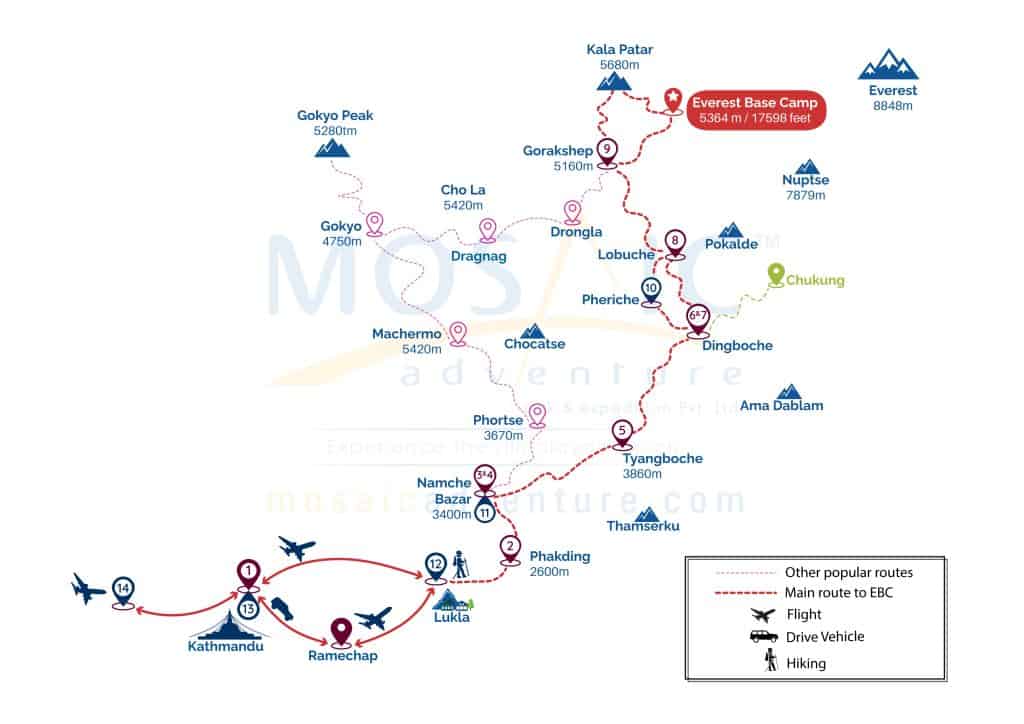
16. When to do Everest Base Camp Trek?
Best time for a trek to Everest Base Camp is during the pre-monsoon (spring) and post-monsoon (autumn) seasons.
In spring (March to mid June) the weather is usually stable with clear blue skies, mild temperatures and beautiful blooming rhododendron forests at lower altitude.
Autumn (September to November) almost have similar advantages with more stable weather, much clear visibility and one of the best trekking conditions.
Weather and Temperature Breakdown for Everest Base Camp Trek
Spring Season (March to May)
Weather is generally stable during the spring season, with clear blue skies and mild temperatures. There is a low chance of rain and any rainfall is minimal.
Daytime temperatures at lower altitudes (e.g., Lukla, Namche Bazaar) range from 10°C to 20°C (50°F to 68°F).
Nighttime temperatures can drop to around -5°C to -10°C (23°F to 14°F) at higher altitudes, such as Gorkashep.
Monsoon Season (June to August)
During monsoon season, lower altitudes experience more rainfall, while higher altitudes may have cloudy conditions with limited mountain views.
Daytime temperatures at lower altitudes range from 15°C to 25°C (59°F to 77°F).
Nighttime temperatures can drop to around 0°C to -5°C (32°F to 23°F) at higher altitudes.
Autumn Season (September to November)
Weather in the autumn season is similar to spring, with stable conditions, clear skies and mild temperatures. There is some chance of light rain in early September to the third week of September.
Daytime temperatures at lower altitudes range from 10°C to 20°C (50°F to 68°F).
Nighttime temperatures can drop to around -5°C to -15°C (23°F to 5°F) at higher altitudes.
Winter Season (December to February)
Winter brings cold temperatures and occasional snowfall to the Everest region. Despite the cold, you can experience clear skies and beautiful mountain views. Be prepared for freezing nights.
Daytime temperatures at lower altitudes range from 5°C to 10°C (41°F to 50°F).
Nighttime temperatures can drop significantly to -15°C to -25°C (5°F to -13°F) at higher altitudes.
You should note that weather conditions in the Himalayan regions can be unpredictable and temperatures can change rapidly with altitude.
Always check weather forecast before beginning your trek and pack appropriate clothing for both warm and cold weather. Being prepared for varying conditions will ensure a comfortable and safe trekking experience to Everest Base Camp.
17. Can you trek to Everest Base Camp during the monsoon season?
Everest Base Camp trek in August or during the full monsoon season (June to August) is definitely possible.
Although it comes with its own set of challenges it do have some advantages like less crowd, greener sceneries and mild temperature.
However, the monsoon can bring rainfall especially at lower altitude. On top of monsoon, cloudy weather may also limit visibility of the stunning Himalayan peaks.
It’s important to be prepared with appropriate gear and carefully assess the weather and trail conditions before undertaking the trek during the monsoon season. On top of this, the season being rainy and cloudy, it can also affect Lukla flight.
Therefore keep additional buffer days post trek to avoid missing return flight.
18. Can you trek to Everest Base Camp during the winter season?
Everest Base Camp during Trek during winter season (December to February) can be challenging due to cold temperatures and snowy weather conditions.
Proper equipment including proper warm clothes is essential as temperature can drop to as low as minus 25 Degrees Celsius or minus 13 degrees Fahrenheit.
19. Do I need insurance for Everest Base Camp Trek?
Yes, it is highly recommended to have travel insurance when going on the Everest Base Camp trail. Travel insurance provides coverage in case of medical emergencies like altitude sickness or injuries.
As there is no hospital along the trail it is useful to have insurance that covers emergency evacuation by helicopter whoever required as per your conditions.
Other than that, travel insurance covers against trip cancellations or interruptions due to unforeseen circumstances such as flight cancellations.
20. Do you lose weight on Everest Base Camp Trek?
EBC trek requires significant physical effort that which can lead to calorie burn and potential weight loss.
The demanding terrain and long hours of walking can increase energy consumption resulting in weight loss.
However, maintaining proper nutrition is crucial during the trek to sustain energy levels and prevent excessive weight loss.
21. How busy or crowded is Everest Base Camp Trek?
Trail to Everest Base Camp can be quite busy during peak seasons, especially in spring (March to May) and autumn (September to November).
During these times the route have moderate to high levels of trekkers.
To avoid excessive crowds, consider trekking during the shoulder seasons like around early spring (mid Feb to mid March) or late autumn (mid November to mid December).
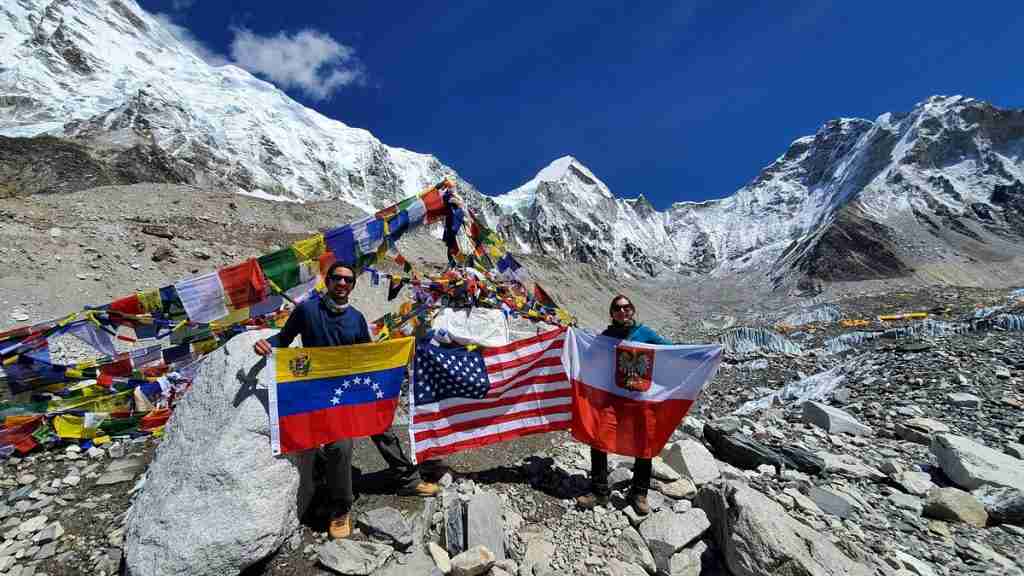
22. How many people do Everest Base Camp Trek?
Each year large number of trekkers visits Everest Base Camp but there aren’t actual recorded numbers. Estimates suggest that about 12-14 thousands trekkers book Everest Base Camp Trek every year.
23. How many suspension bridges are on Everest Base Camp Trek?
This route features several suspension bridges and in total there are eight suspension bridges on Everest Base Camp Trek.
These bridges include two near Phakding, one in Monjo, one in Jorsalle, two in Namche Bazaar, one in Tengboche and one on the way to Dingboche.
Crossing these bridges adds an adventurous element to the trek providing stunning views of rushing rivers and deep gorges.

24. How much is food on Everest Base Camp Trek? What to eat on the Everest Base Camp Trek?
Cost of food on the Everest Base Camp Trek can vary depending on the location, lodge and food you choose. In an average, you will be spending about USD 550 to 2000 per person depending on factors outlined above.
The trek offers varieties of food options like local Nepali dal bhat, momos (dumplings), noodles, Sherpa stew etc.
You can also find international dishes like pasta, pizza, and pancakes. It is suggested to carry some energy bars and snacks for additional nourishment during long walking days.
Make sure to eat balanced diet that includes carbohydrates and proteins to keep your energy levels up. Proper nutrition helps your body adjust to high altitudes.
25. How much to tip your guide and porter on Everest Base Camp Trek?
Tipping your guide on Everest Base Camp Trek is a customary practice and a suggested guideline is around $120 to $150 per participant. For porter, a recommended tip is around $60 to $80 per participant.
These amounts are as per cultural norms and industry standards and serve as a token of appreciation for their hard work and support throughout the trek.
26. How often are trekkers affected by altitude sickness on Everest Base Camp Trek?
Altitude sickness such as acute mountain sickness (AMS) can occur on Everest Base Camp Trek due to high altitude, but there aren’t actual recorded figure of this.
Proper acclimatization, gradual ascent, staying hydrated, recognizing symptoms (headache, nausea, dizziness), and descending if symptoms worsen are really important to prevent altitude related sickness.
27. How to avoid altitude sickness during your Everest Base Camp Trek?
Preventing altitude sickness is really important for a safe and enjoyable trek to Everest Base Camp. Here’s more detailed information and tips on how to protect yourself from altitude sickness while trekking at altitudes above 5,500 meters.
Slow and Steady Ascent with Proper Acclimatization
Allow your body to adapt gradually to the increasing altitude on the trail. Avoid rapid gains in altitude, especially as you reach elevations above 3,000 meters.
Follow a slow and steady pace while ascending to give your body time to adjust to the reduced oxygen levels and acclimatize effectively.
Choose an itinerary that allows for a gradual ascent with enough acclimatization days. Acclimatization is key to a successful Everest Base Camp Trek.
Ensure you have at least 2 acclimatization days in Namche Bazaar and Dingboche before heading towards EBC.
Pace yourself and avoid pushing yourself beyond your ability, especially during steep uphill climbs. Rest when necessary and don’t push yourself beyond your limits.
Drink Plenty of Water / Stay Hydrated
Stay hydrated by drinking plenty of water throughout your trekking day. Keep track of your fluid intake to ensure you are adequately hydrated.
Proper hydration helps your body cope with altitude, adjust to low oxygen levels, and reduces the risk of altitude sickness.
Avoid smoking and alcohol, as they can dehydrate you and decrease oxygen levels in your body. Try your best to avoid smoking and drinking alcohol while heading towards EBC.
Learn About Symptoms and Pack Medicines that are right for you
Educate yourself about the symptoms of altitude sickness and frequently assess your well being.
Symptoms may include tingling fingers, headaches at the back of your head, nausea, dizziness, loss of appetite, difficulty sleeping etc.
Listen to your body and if you experience any of these symptoms, don’t ignore them. Speak to your guide immediately for appropriate action.
Before coming to Nepal, consult with your doctor and bring medicines suitable to prevent altitude related sickness .
28. How steep is Everest Base Camp Trek?
Everest Base Camp Trek involves both gradual ascents and steeper sections. While most of the trail has a moderate gradient, there are certain sections with steeper inclines, such as the ascent to Namche Bazaar and Tyangboche.
29. Is there a phone connection at Mt. Everest Base Camp Trek?
There are phone connections along the Everest Base Camp route, but it is not reliable.
Phone connections are available in places like Lukla, Phakding, Namche, and Tyangboche but there is no phone connection above Tyangboche until you reach Everest Base Camp.
Due to the unreliable nature of these connections, it is recommended not to 100 percent rely on them for communication during the trek.
30. Is there a Wi-Fi connection at Mt. Everest Base Camp Trek?
Wi-Fi connections and internet access are available at all teahouse stops en route to Everest Base Camp.
But, it’s important to note that the quality and reliability of the Wi-Fi is not that great.
It is advisable to not rely solely on Wi-Fi for communication or internet needs during the trek and instead enjoy the natural beauty and the experience of being disconnected from the actual world.
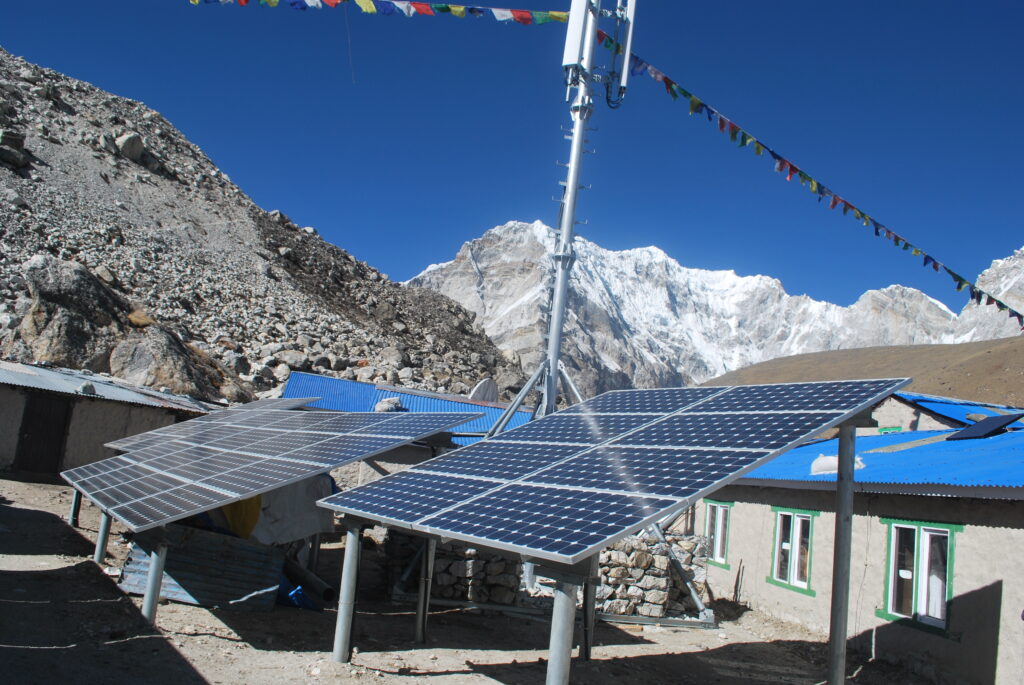
31. When to exchange money for Everest Base Camp Trek?
It is recommended to exchange money for Everest Base Camp Trek in Kathmandu, specifically in the Thamel area where exchange rates are generally better compared to those on the trail.
While it is possible to exchange money along the trail, rates may not be as good as in Kathmandu.
Therefore, it is advised to handle currency exchange in Kathmandu before flying in to Lukla to start the trek.
32. Where does Everest Base Camp Trek start from?
Everest Base Camp Trek starts from Lukla. It is a small town in the Solukhumbu District of Nepal.
To reach Lukla, trekkers mostly take a flight from Manthali Airpor to Lukla after early morning drive from Kathmandu to Ramechhap (Manthali).

33. Which trek is harder between Everest Base Camp or Kilimanjaro?
Both Everest Base Camp Trek and Kilimanjaro trek present their own unique challenges and differences.
Everest Base Camp Trek involves high altitude reaching over 5,364 meters (17,598 feet) with gradual ascents and descents over varied terrain.
The Kilimanjaro trek, on the other hand, reaches a higher altitude of 5,895 meters (19,341 feet) but involves a shorter duration ascent with steeper sections.
Kilimanjaro is known for its extreme altitude effects while Everest Base Camp trek requires endurance and acclimatization.
Both treks require physical fitness, but Kilimanjaro’s steeper terrain and higher altitude can make it slightly more challenging. Personal preferences and prior experience, ultimately determine which trek is considered harder.
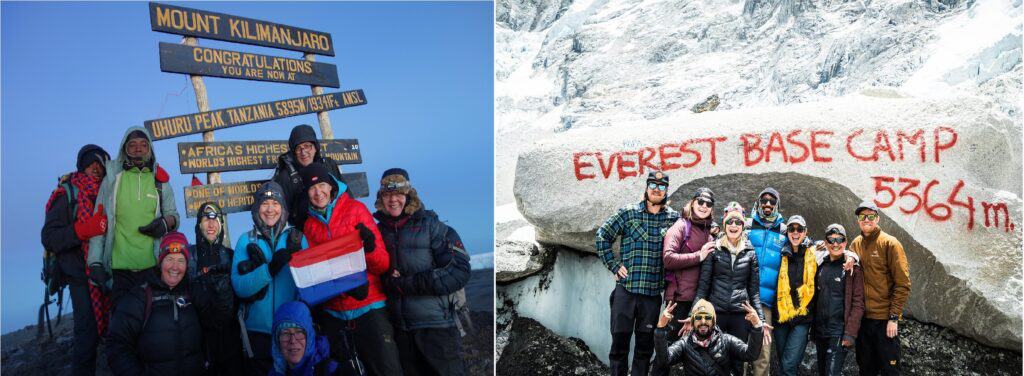
Conclusion
I hope this ultimate guide to Everest Case Camp is helpful in answering all your questions related to Everest Base Camp Trek.
By addressing all your questions and concerns I should have provided you with the necessary knowledge to plan and undertake this remarkable journey.
Remember to prepare well, respect the environment, cherish every moment as you trek through the breathtaking Himalayan landscapes and don’t forget the hard working guide and porter at the end of your trek.
Get ready for an unforgettable and life-changing experience of a lifetime! And, don’t forget to get in touch with me if you have more questions or need additional information related to this Himalayan adventure.
Want more information? Send us your query, and our experts will get back to you within 24 hrs.
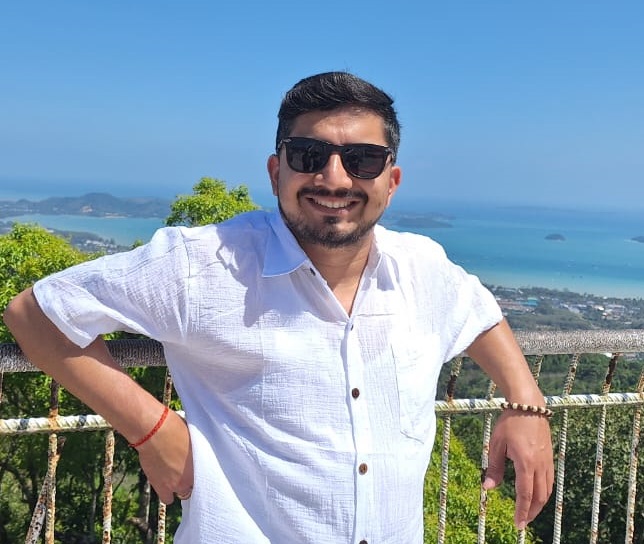
Madhav started working as a porter in 2001 and then moved on to work as a trekking guide. After working in the trekking and tourism industry for eight years, he co-founded Mosaic Adventure in 2009.
Madhav has trekked to most of the trekking destinations in Nepal, including Everest Base Camp Trek, Annapurna Base Camp, Annapurna Circuit Trek, Poon Hill Trek, Jomsom Muktinath Trek, Indigenous Peoples Trek, Langtang Valley Trek, Mardi Himal Trek, and all of the day hikes around Kathmandu.
He has also extensively traveled to other countries such as Australia, the USA, the UK, France, Hong Kong, Japan, China, the Philippines, the UAE, Saudi Arabia, Bahrain, Thailand, Turkey, and India. Madhav is the one who answers most of your questions about trekking and tours and helps to plan your trip by giving a personal touch.


